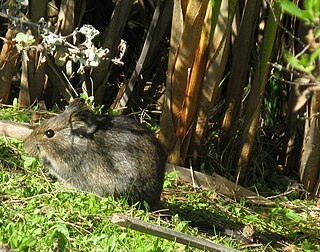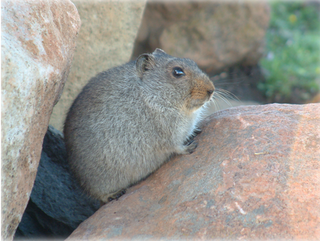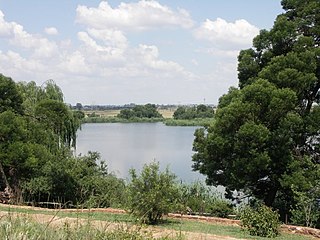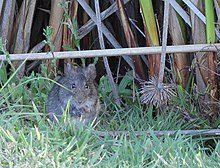
The maned rat or (African) crested rat is a nocturnal, long-haired and bushy-tailed East African rodent that superficially resembles a porcupine. The world's only known poisonous rodent, the maned rat sequesters toxins from plants to fend off predators.
The Amazonian marsh rat, also known as the common marsh rat, or simply the marsh rat, is a rodent species from South America.

African vlei rats (Otomys), also known as groove-toothed rats, live in many areas of sub-Saharan Africa. Most species live in marshlands, grasslands, and similar habitats and feed on the vegetation of such areas, occasionally supplementing it with roots and seeds. The name "vlei" refers to the South African term for intermittent, seasonal, or perennial bodies of standing water.
The Angoni vlei rat is a species of rodent in the family Muridae. It is found in Botswana, Kenya, Malawi, Mozambique, South Africa, Eswatini, Tanzania, Zambia, and Zimbabwe.
Burton's vlei rat is a species of rodent in the family Muridae. It is found only in Cameroon. Its natural habitats are subtropical or tropical high-altitude shrubland, subtropical or tropical high-altitude grassland, and swamps. It is threatened by habitat loss.
Dollman's vlei rat is a species of rodent in the family Muridae. It is found only in Kenya. Its natural habitats are subtropical or tropical high-altitude grassland and swamps. It is threatened by habitat loss. Some authorities, including the IUCN, regard it as a synonym of Otomys tropicalis.
The laminate vlei rat is a species of rodent in the family Muridae. It is found only in South Africa. Its natural habitats are subtropical or tropical high-altitude grassland and swamps.
The western vlei rat is a species of rodent in the family Muridae. It is found in Cameroon and Nigeria. Its natural habitats are subtropical or tropical high-altitude grassland and swamps. It is threatened by habitat loss.
Saunder's vlei rat is a species of rodent in the family Muridae. It is found only in South Africa. Its natural habitats are subtropical or tropical dry shrubland, Mediterranean-type shrubby vegetation, and subtropical or tropical high-altitude grassland.

Sloggett's vlei rat or ice rat is a species of rodent in the family Muridae. It is found in southern Lesotho and South Africa where its natural habitats are subtropical or tropical high-altitude grassland, swamps, and rocky areas. Its name commemorates Col. Arthur Sloggett who served in South Africa and collected at Deelfontein in 1902. This is a common species and the International Union for Conservation of Nature has rated it as being of "least concern".
The tropical vlei rat is a species of rodent in the family Muridae. It is found in Burundi, Democratic Republic of the Congo, Kenya, Rwanda, South Sudan, and Uganda. Its natural habitats are subtropical or tropical seasonally wet or flooded lowland grassland, subtropical or tropical high-altitude grassland, swamps, and plantations.
The Ethiopian vlei rat is a species of vlei rat in the rodent family Muridae. It is found only in Ethiopia and is considered endemic.

The bush vlei rat or Karoo bush rat is a species of rodent in the family Muridae. It is found in Namibia and South Africa. Its natural habitat is temperate shrubland. The Karoo rat uses behavioral adaptations to cope with the dry arid climate. It is a medium-sized rodent with a dark pelage on top and lighter underneath. It has light colored feet and a dark tail. The rat may have light colored fur around its eyes and the back of its ears.
The Uzungwe vlei rat is a species of rodent in the family Muridae. It is found in Malawi, Tanzania, and Zambia. Its natural habitats are subtropical or tropical high-altitude grassland and swamps. It is threatened by habitat loss.

The African grass owl is a species of owl in the barn owl family, Tytonidae.

Rietvlei Nature Reserve, located in southern Pretoria, is about 4,000 hectares (40 km2) in size, and includes the entirety of the Rietvlei Dam which impounds the Rietvlei River, in Gauteng, South Africa. The reserve is wedged between the R21 highway on the western side and the R50 (Delmas-Bapsfontein) road on the north-east. The mean elevation above sea level is approximately 1,525 meters, with the highest point at 1,542 m and the lowest at 1,473 m, the dam’s outflow in Sesmylspruit. The reserve covers a surface area of approximately 4,003 ha or 40 km2, of which the dam constitutes some 20ha. A network of roads criss-cross the entire area, which facilitates access to visitors and management.







